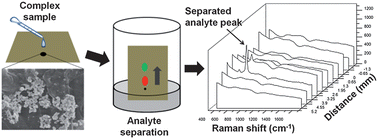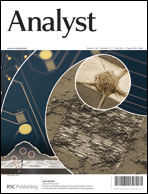Chromatographic separation and detection of target analytes from complex samples using inkjet printed SERS substrates†
Abstract
In principle, surface enhanced Raman spectroscopy (SERS) is thought to provide unique identification of a target analyte, even in complex samples or in the presence of multiple analytes. In practice, however, this is not always true for real-world samples due to various forms of interference. In this report, we build upon our previous work on inkjet-printed SERS substrates by using paper and polymer membranes to integrate sample cleanup and analyte separation with SERS detection. Inkjet-printed paper SERS substrates provide a highly sensitive chemical detection platform of unprecedented cost and simplicity. In addition, paper inherently provides unique capabilities, such as capillary-actuated fluid transport and selective molecular retention. Utilizing these properties, we demonstrate two-dimensional chromatographic separation and SERS detection on inkjet-printed paper SERS substrates. Then, we leverage the separation properties of paper and polymer membranes for real applications that feature complex sample matrices, including the detection of down to 5 ppm melamine in infant formula, as well as the quantification of nanograms of heroin in samples contaminated with a highly fluorescent background. The results presented here demonstrate that inkjet-printed paper SERS devices not only provide advantages in terms of sensitivity and cost, but the paper provides inherently integrated sample cleanup capabilities that are not available in traditional SERS substrates and microfluidic SERS devices. These unique capabilities of paper SERS devices enable the identification of targeted analytes even in complex real-world samples.


 Please wait while we load your content...
Please wait while we load your content...